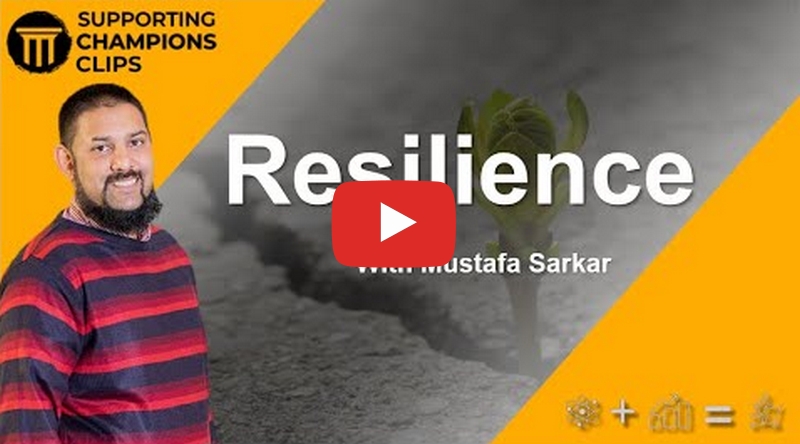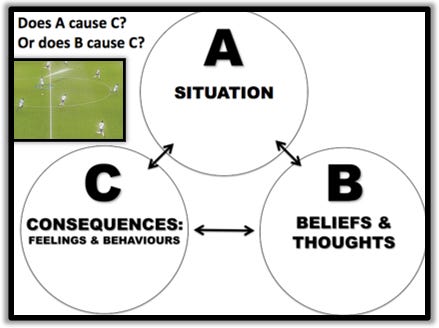How to coach resilience
‘‘Resilience is being able to Overcome Adversity. You Experience, You Fail, Hurt, Fall, But You Keep Going’’ (Mogahed, Y)
Contents:
- What is resilience plus tips on how to develop it?
- Coaching tips and action steps to develop resilience.
- Session Share: Three Team Game Squad Practice.
- Problem/Fix: Identify and fix a common error young players make.
- Spotlight: How to coach feints.
- Coach Project: Complete the three tasks to improve player resilience.

What is Resilience?
Resilience is a set of attitudes, behaviors, and responses to short or long-term adversities. In hockey, it refers to a player’s ability to withstand challenges, setbacks, and pressure, both on and off the pitch.
If Resilience is coming back from frequent struggles. Then Attitude is the ingredient to get you through it. To develop resilience, players must.
- Work on things that can be changed.
- Adjust to things that cannot be changed.
- Recognize that struggle should not put you off your goals.
Truly resilient people move forward despite the struggles and pressures that come their way they have a progressive attitude.
Being resilient won’t make things better but the the learning and information provided throughout the struggle can change you for the better.
Resilience is an individual response however, it can be influenced by external factors such as coaches and teammates. The more supportive these influences are, the more helpful they can be to the individual’s perception of the situation.
To develop resilience your attitude is essential. You can learn skills to help you adapt to your struggle. The lessons that you learn through challenging situations act as future preparation for those that lie ahead.
Benefits of Challenging Situations
- The way you see yourself changes:
You can go from worried and scared to committed and determined.
- Support Networks:
You get to see who your true supportive influences are. Who is willing to help and also people who are not this can strengthen your feelings and relationships.
- Shift your thinking:
Challenging situations can help you change your view of something and help you prioritize.
- Experience emotions:
You get to feel emotions that maybe you have never felt before.
Tough situations often bring with them negative emotions. It’s important to note when experiencing negative emotions that having a flexible not rigid response is vital to the speed at which you overcome or deal with the challenge.
During these times there is information that needs your attention. The player needs to identify what that detail is and then take action quickly. Negative emotions are NOT the problem. They become a problem when they stop you from taking ACTION STEPS to change.
How to make the most of a bad situation:
When a challenging moment arrives players can use the following steps to help themselves overcome it.
- Identify what you can and cannot change.
- If the situation can be changed, take immediate, necessary actions.
- If it can’t be changed then work on changing your emotional response to it.
Behavior can be divided into action tendencies and clear actions.
For example, let’s say a player has made a mistake and responded poorly. You ask them about it later and they can tell you what they should have done (action tendency).
The player needs to get to a point where they acknowledge the emotion in that moment but ACT instead of delaying to rectify the situation or struggle with their mistake (clear action).
Manage Your Emotions
Resilient responses from players will often include emotional pain or frustration. It’s tempting for the player to react poorly or not react at all because they do not want to fail/struggle or mess up again. In the short term, this process can work as it avoids consecutive struggles.
BUT
This can become an issue for the players as they are teaching themselves that responses to setbacks are unbearable and should be avoided whenever possible. The players will not take the risks they need to to become better performers.
Resilience is forged through challenge, struggle, and the willingness to take it on anyway. Poor reactions to struggle are often the player’s way of avoiding or delaying so they do not expose themselves to setbacks.
IMPORTANT
Players do not have to win/overcome every struggle. Performers will not get to a point where resilience has been mastered and they won’t feel overwhelmed by anything.
Instead, encourage the player to focus on getting their ratio of helpful responses (clear actions) higher than that of unhelpful responses (action tendencies). The 80% of the time helpful and 20% unhelpful responses are a good target to shoot for in building a resilient mind.
‘Resilience is Ordinary, Not Extraordinary’
Everyone can be resilient. It’s not magic, it’s not a gift from the gods, you are not born with it.
Resilience is learnable.
How to develop resilient players?
- It’s on them:
Players need to take personal responsibility for their journey. They need to acknowledge their pains and struggles. Be willing to use trial and error to overcome (80% helpful,20% unhelpful). Establish their support networks (Coaches can be a great help and offer support).
- It is in the doing:
Resilient behaviors come down to action. It involves doing things that make them uncomfortable, or they do not like to do. But they do it anyway for the longer-term benefit the action brings.
- Shared Struggle:
Each journey looks different, there is no clear map to success. Players should be open to sharing what they find tough and seeking out actions that can be helpful to them.
- Attitude shapes actions:
Thoughts, emotions, and behavior are the three components of attitude. A player’s attitude toward struggle involves coping with and processing these factors. Players must be open, flexible, and adaptable to try different methods to overcome adverse situations.
- Flexible Thinking:
For players to adapt to new situations, resilient attitudes should be flexible by nature. Accept that struggle has occurred. Identify what is and isn’t under the player’s control to change. Try out different responses to overcome the struggle.
How can you, the coach help?
 The ABC model is a cognitive-behavioral thinking tool often used in psychology to understand the connection between activating events, beliefs, and consequences.
The ABC model is a cognitive-behavioral thinking tool often used in psychology to understand the connection between activating events, beliefs, and consequences.
Coaches can employ this tool to help players manage their thoughts and emotions during challenging situations.
- Activating Event (A):
This represents the specific event or situation that triggers a player’s response. In soccer, it could be, a mistake that leads to a goal, a bad refereeing decision, or any other event that elicits an emotional reaction.
- Beliefs (B):
B refers to the player’s beliefs or thoughts about the activating event. These beliefs can be either rational and helpful or irrational and unhelpful. Coaches can guide players to identify and analyze their thoughts in response to the event.
- Consequences (C):
C encompasses the emotional and behavioral consequences of beliefs about the activating event. Positive beliefs often lead to constructive emotions and actions, while negative beliefs may result in frustration, anxiety, or suboptimal performance.
Application
Here are some applications of the ABC tool. This is a tough topic and often requires more than a fly-by in training, it often needs regular support, encouragement, and implementation.
- Observation (Activating Event):
Identify a specific event during a game or training session that triggered a notable reaction from the player. It could be a missed opportunity, a mistake, or a challenging situation.
- Discussion (Beliefs):
Engage in a conversation with the player about their thoughts and beliefs related to the identified event. Please encourage them to express what went through their mind during that moment. Explore whether their beliefs are rational and constructive or irrational and detrimental.
- Challenge Irrational Beliefs:
If the player’s beliefs are irrational or overly negative, work with them to challenge and reframe those thoughts. Help them see alternative perspectives and develop more balanced, constructive beliefs.
- Explore Consequences:
Discuss the emotional and behavioral consequences that followed their beliefs about the event. Help the player recognize patterns in their reactions and understand the impact of their thoughts on their performance.
- Develop Positive Beliefs:
Guide the player in cultivating positive and realistic beliefs about challenging situations. Encourage a growth mindset, emphasizing the potential for learning and improvement.
Quick and (not so) easy
Here is a 3 step action list that players can use to refocus during challenging moments.
- Remind and Step back:
Encourage the player to use a positive statement about their mindset that they can identify with ‘Intensity is my Identity’. Get the player to imagine stepping back from the error, or challenge they are facing and repeat their mindset statement.
- Refocus and Step Up:
Now get the player to refocus by thinking about some actions they can control. Get the player to imagine stepping up and looking down on everything and seeing themselves performing the actions they used to refocus.
- Respond and Step In:
Finally get the player to respond by stepping into the body of the new refocused player who performs the controllable aspects of their game.
Home » Culture & Mindset » Mindset » Resilience » How to coach resilience
 The ABC model is a cognitive-behavioral thinking tool often used in psychology to understand the connection between activating events, beliefs, and consequences.
The ABC model is a cognitive-behavioral thinking tool often used in psychology to understand the connection between activating events, beliefs, and consequences.